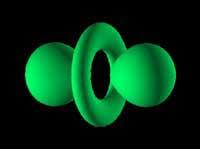First detection of superheavy hydrogen
an experiment conducted on the Japanese RIKEN detector, the signal of 5 superheavy hydrogen atoms has been detected. There are no 5 hydrogen atoms on Earth in a natural state, but physicists believe it is within the stars. They were 40 years after the signal.

Hydrogen is the simplest atom in nature, with a proton in the nucleus and a single electron rotating around it. The most common hydrogen does not contain neutrons in the nucleus, but there are other types of hydrogen with neutrons in the nucleus. Atoms with equal numbers of protons in the nucleus but different numbers of neutrons in science are called isotopes; isotopes are variants of the same element. As for hydrogen, there are two stable isotopes: deuterium and tritium. The first has a proton and a neutron in the nucleus and the second has a proton and two neutrons. Compared to common hydrogen, they are in a very small proportion in nature.
The hydrogen isotope detected in the Japanese RIKEN detector consists of one proton and four neutrons in the nucleus, being extremely unstable. Therefore, physicists believe that it is only within the stars. It is believed that within the stars there are many unstable and rare atoms and particles, and physicists have a lot of interest in them, as they can be a way to increase the knowledge of the stars and the universe in general.
Buletina
Bidali zure helbide elektronikoa eta jaso asteroko buletina zure sarrera-ontzian











